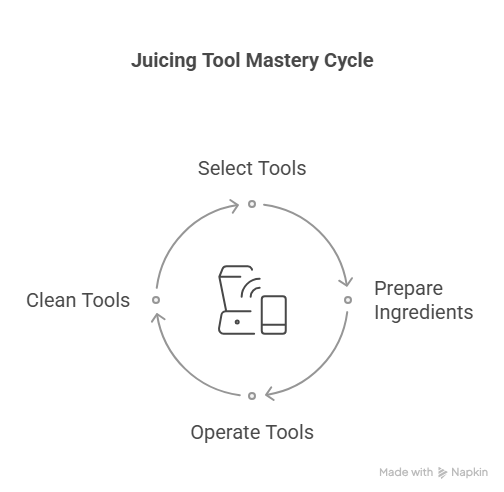
Juicing has become a popular health trend, offering a convenient way to consume a variety of fruits and vegetables in a single glass. For those new to juicing, the array of tools and equipment can be overwhelming. This guide to juicing tools for newbies aims to simplify the process by outlining essential juicing tools, their functions, and tips for getting started on your juicing journey.
1. Choosing the Right Juicer
Types of Juicers
- Centrifugal Juicers: These are the most common and affordable juicers. They use a fast-spinning blade to chop and extract juice from fruits and vegetables. Best for beginners due to their ease of use and quick operation.
- Masticating Juicers: Also known as slow juicers, these operate at a slower speed, crushing and squeezing produce to extract juice. They tend to yield more juice and preserve nutrients better but are usually more expensive and take longer to clean.
- Citrus Juicers: Specifically designed for citrus fruits, these juicers can be manual or electric. They are great for making fresh orange or lemon juice.
Recommendations
For beginners, a centrifugal juicer is often the best choice due to its affordability and speed. However, if you plan to juice leafy greens or want to maximize nutrient retention, consider investing in a masticating juicer.
2. Essential Accessories
Cutting Board and Knife
A sturdy cutting board and a sharp knife are essential for preparing your fruits and vegetables. Make sure to wash and chop your produce into manageable pieces before juicing.
Measuring Cups
Using measuring cups can help you keep track of how much juice you’re making and ensure you have the right balance of ingredients.
Storage Containers
Invest in airtight containers or glass jars to store your freshly made juice. This will help preserve its freshness and nutrients for a longer time.
Strainer or Cheesecloth
If you prefer a smoother juice, a strainer or cheesecloth can help remove pulp from your juice after extraction.
3. Cleaning Tools
Brush for Juicer Parts
Many juicers come with a cleaning brush to help you clean the mesh filter and other parts. Keeping your juicer clean is crucial for maintaining its performance and longevity.
Dish Soap and Sponge
A gentle dish soap and sponge are essential for cleaning your juicer after each use. Make sure to rinse all parts thoroughly to avoid any soap residue.
4. Getting Started with Juicing
Selecting Ingredients
Start with a mix of fruits and vegetables that you enjoy. Common beginner-friendly options include apples, carrots, spinach, and cucumbers. Experiment with different combinations to find your favorite flavors.
Juicing Process
- Wash Your Produce: Thoroughly wash all fruits and vegetables to remove dirt and pesticides.
- Prepare Your Ingredients: Cut your produce into smaller pieces that will fit into your juicer.
- Juice: Follow the instructions for your specific juicer model. Start with softer fruits and follow with harder vegetables.
- Strain (Optional): If you prefer a smoother juice, strain it through a cheesecloth or fine mesh strainer.
- Store or Serve: Enjoy your juice immediately or store it in an airtight container in the refrigerator.
5. Tips for Success
- Start Simple: Begin with simple recipes and gradually experiment with more complex combinations as you become comfortable with the process.
- Stay Hydrated: Juicing can be a great way to increase your fluid intake, but remember to drink water throughout the day as well.
- Listen to Your Body: Pay attention to how your body reacts to different juices and adjust your recipes accordingly.
Conclusion
Juicing can be a fun and rewarding way to boost your health and incorporate more fruits and vegetables into your diet. By equipping yourself with the right tools and following this step-by-step guide, you’ll be well on your way to becoming a juicing pro. Enjoy the journey and the delicious, nutritious juices you create!
Don’t stop here! Read 10 Best Tools for Effortless Orange Juicing!